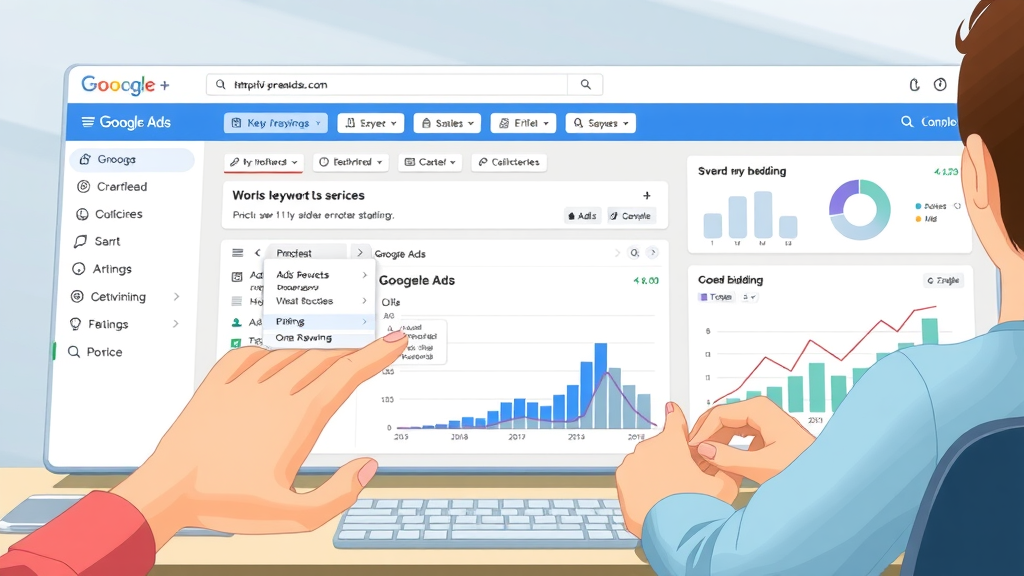Did you know that nearly 40% of Google Ads budgets are lost due to poor campaign structure and lack of optimization? If you’re running google ads or thinking about starting, this one oversight could drain your marketing budget faster than you imagine. In this article, we’ll expose the most expensive missteps in google ads and show you how to avoid becoming just another statistic.
The Startling Truth About Google Ads: What Most Advertisers Get Wrong
Opening with a Shocking Statistic: The Costly Challenges of Google Ads
"According to industry research, nearly 40% of Google Ads budgets are wasted due to poor campaign setup or lack of optimization."
These numbers should make every advertiser take a pause before hitting “Go” on another google ads campaign. Whether you're a seasoned marketer or a small business owner, it’s easy to get swept up in the promise of digital advertising’s reach. However, the reality is that a single oversight in your google ads account structure or targeting can wipe out your hard-earned dollars long before you reach your potential customers. Successful advertisers understand that creating a new google ads campaign is not just about flipping a switch. It’s about building a solid, data-driven strategy—the kind that keeps your budget protected and delivers genuine ROI. Let’s break down exactly where most people go wrong, and how you can avoid these common, expensive mistakes.

What You'll Learn About Google Ads Strategy Mistakes
- The key Google Ads mistakes draining your budget
- How to properly structure a Google Ads account and campaigns
- Best practices for targeting potential customers
- Effective ways to use Performance Max and Merchant Center
- Actionable tips for maximizing ROI with Google Ads
Understanding Google Ads: Core Principles and Pitfalls
What is Google Ads and How Does It Work?
Google Ads is the leading online advertising platform, enabling you to display promotional listings across Google Search, YouTube, and millions of partner sites and mobile apps. At its core, the platform operates as an auction—you bid on keywords people search for, and your ads compete for visibility based on relevance, quality, and bid amount. If you win, your ad is shown to the right audience at the right moment. But launching a successful campaign goes far beyond just picking keywords. You need to set up your google ads account deliberately, segment ad groups by intent, and continuously analyze key metrics through tools like Google Analytics to boost performance.
Failing to follow best practices, such as separating search and display networks, or not integrating your merchant center for e-commerce, can dramatically reduce your results. This is why it's crucial to create multiple ad groups strategically and leverage all available products from Google to reach your potential customers effectively. Understanding how google ads work will shape every aspect of your digital marketing efforts and ultimately decide whether your investment results in new customers or wasted spend.
For advertisers who want to ensure their Google Ads management is both efficient and cost-effective, it's important to address common pitfalls early. If you're looking for actionable solutions to streamline your campaigns and avoid unnecessary spend, explore these proven approaches to solving Google Ads management without wasting cash.

The True Cost of Running a Google Ad
Before diving into google ads, it’s important to know that the actual cost of a google ad varies incredibly by industry, competition, geography, and keywords. While some keywords may only cost cents per click, others in competitive niches can run up to tens or even hundreds of dollars. Here’s a comparison to illustrate just how much average costs can fluctuate:
| Industry | Avg. Cost Per Click (CPC) | Avg. Daily Budget | Key Considerations |
|---|---|---|---|
| Legal | $6.75 | $100–$250 | High competition, must track conversions |
| Retail/Ecommerce | $1.65 | $50–$150 | Use merchant center & Performance Max |
| Real Estate | $2.37 | $60–$120 | Focus on local targeting, high lead value |
| Healthcare | $2.78 | $80–$200 | Strict targeting, ad copy regulations |
| Technology/SaaS | $3.89 | $100–$300 | Use remarketing, track mobile app installs |
Whether you’re advertising your new mobile app, business profile, or product catalog, setting and monitoring your google ads budget is essential in preventing costly surprises. Next, let’s look at the most common reason advertisers lose money…
The Most Common Google Ads Mistake: Neglecting Campaign Structure
Why a Well-Organized Google Ads Campaign Matters
Arguably the number-one mistake in google ads is neglecting your campaign’s structure. Too many advertisers mix their search and display campaigns, lump all keywords into generic ad groups, and rely on broad match without negative keywords. These errors lead to low-quality clicks, wasted impressions, and a diluted message that doesn’t truly reach their potential customers.
A solid campaign structure is the backbone of google ads success. By segmenting ad groups by theme or intent, using targeted match types, and applying negative keywords, you maintain granular control over your budget and improve your cost-per-conversion. Additionally, leveraging the hierarchy within your google ads account—from campaigns to ad groups to ads—ensures you can track what’s working and scale accordingly. Failing to do so often means you’re spending more on low-converting traffic instead of optimizing for real ROI.
- Mixing search and display campaigns
- Neglecting match types and negative keywords
- Lack of ad group segmentation
- Failing to use Google Ads account hierarchy effectively

Real-World Case Study: The Financial Impact of Google Ads Errors
Let’s look at a real example that demonstrates just how much account structure can impact the bottom line. Many business owners start with the default recommendations—one campaign, single ad group, plenty of broad keywords, no negative keywords, and no audience segmentation. The result? Sky-high spending and low conversions. In this case study, a small e-commerce retailer restructured their google ads account, created multiple tightly themed ad groups, and began actively monitoring conversion data with Google Analytics. The transformation was dramatic—not just in savings, but in actual revenue generated from their paid ads.
| Metric | Before Restructuring | After Restructuring |
|---|---|---|
| Total Monthly Spend | $2,250 | $1,530 |
| Click-Through Rate (CTR) | 1.2% | 3.9% |
| Cost per Conversion | $63 | $34 |
| Monthly Conversions | 36 | 74 |
"After restructuring my Google Ads account, I cut costs by 32% and doubled my conversions within two months." — PPC Specialist

Performance Max and Merchant Center: Are You Missing Out?
Leveraging Performance Max in Your Google Ads Strategy
Google’s Performance Max campaign type is one of the most powerful tools for advertisers aiming to streamline their reach and maximize results. Performance Max leverages machine learning to optimize your ads across every channel—Search, Display, YouTube, Discovery, Maps, and Gmail—using a single campaign setup. For businesses with a variety of business products or those who want to reach people wherever they are, integrating performance max into your google ads account can unlock enormous efficiency and conversion gains. Success depends on feeding the algorithm the right data, creative assets, and goals. Don’t overlook this feature, especially if you’ve plateaued with standard search or display campaigns.
Merchant Center Integration: Crucial for Ecommerce Success
If you’re running an online store, integrating with Merchant Center is non-negotiable. The Merchant Center keeps your product feed synced across all Google surfaces—enabling your listings to show up in Shopping Ads, on search, and even image results. This connection not only expands your visibility to potential customers but also boosts campaign automation and data reporting, allowing for precise product-level targeting. Make sure your Merchant Center is fully connected to your google ads account and always up to date with accurate, optimized product feeds for the highest return on investment.

How to Create a New Google Ads Account and Campaign – The Right Way
- Signing up and setting business goals: Begin by creating a new Google account if needed, and then access your google ads dashboard. Clearly define your goals, such as website visits, phone calls, or sales.
- Structuring campaigns and ad groups for clarity: Separate Search, Display, and Performance Max. Build multiple campaigns and ad groups around themes or products.
- Selecting proper targeting options for potential customers: Use demographic targeting, geographic filters, and custom intent audiences to narrow your reach to those most likely to convert.
- Using keyword research and match types: Rely on Google’s Keyword Planner to identify high-performing keywords. Segment by match type and always add relevant negative keywords to filter out unrelated searches.
- Monitoring and optimizing with key Google Ads metrics: After launch, monitor impressions, clicks, CTR, cost/conversion, and ROI. Use Google Analytics and Merchant Center data to adjust bids, pause underperforming ads, or expand on what’s working.
Video: Tutorial: How to Set Up Your First Google Ads Campaign
Potential Customers: Targeting, Segmentation, and Conversion
Understanding your potential customers is at the heart of all successful google ads strategies. Effective targeting means your ads will appear in front of the people most likely to take action—leading to higher conversion rates and lower advertising costs. Here’s how to refine your approach:
- Demographic targeting: Focus on age, gender, household income, and parental status to filter audiences for precise messaging.
- Custom intent audiences: Leverage user intent by targeting people who recently searched for your products, services, or competitors.
- Remarketing strategies: Stay connected with previous site visitors through display, search, or video ads—reminding them to return and convert when ready.
By using these strategies, you boost your chance to reach people who already have shown interest in products from Google or have interacted with your business profile. Combine these insights with Google Analytics and Merchant Center data for unbeatable results.
How Much Should You Spend on Google Ads? Budgeting Tips & ROI
Determining the ideal google ads budget depends on your business size, goals, competition, and customer lifetime value. Setting budgets too low can stall data collection and learning. Spending too much without structure may lead to rapid losses. Here’s a quick budget guide by business type:
| Business Type | Suggested Starting Daily Budget | Advice |
|---|---|---|
| Solo Professional (e.g. consultants) | $15–$30 | Focus on search-based lead generation, track all calls |
| Small Local Business | $25–$75 | Test location targeting, adjust based on calls or visits |
| Ecommerce Store | $40–$125 | Link Merchant Center, use Performance Max or Shopping Ads |
| National Brand | $150–$500 | Include display campaigns and remarketing |
Remember to track every dollar with google analytics and be ready to optimize as you learn what’s truly working. Smart budgeting is the difference between scaling profitably and costly mistakes.
Unlocking Hidden Value: Google Ads Credits and Offers
If you’re just setting up a new Google Ads account, you might qualify for promotional credits or offers—sometimes up to $500. These credits are incredibly valuable for testing campaigns risk-free before committing significant resources. Not only do they help you refine targeting and discover what works, but you can also unlock the credit by following Google’s account setup guidelines or accepting an offer to your account from Google or a certified agency partner.
"Google Ads credits gave our startup a risk-free chance to refine our advertising strategy before scaling investment."

People Also Ask: Essential Google Ads FAQs
How much does Google ad cost?
The average cost per click (CPC) on google ads ranges from $1 to $4 for most industries, but highly competitive sectors like law or insurance can reach $50 or more per click. The total cost depends on your chosen keywords, competition, and daily budget. By properly structuring your ads account and campaigns, you can keep your costs as low as possible while maximizing conversions.
Is $20 a day good for Google Ads?
Starting with $20 a day provides enough data to test and learn, especially for local or niche businesses. While it might not generate massive volume, you can refine your targeting, optimize your ad groups, and analyze your performance using google analytics. As results stabilize, consider scaling up your daily budget to accelerate growth.
What is Google Ads and how does it work?
Google Ads is an online advertising platform by Google where businesses create targeted ads to appear on Google Search, YouTube, and partner networks. Businesses set a budget, select their target audience, and bid on keywords. Google’s algorithm determines which ads show based on relevance, bid, and quality score. Effective account structuring and continuous optimization help reach potential customers and maximize ROI.
How do I get $500 credit from Google Ads?
Google frequently offers promotional credits to new advertisers. To unlock the credit, create a new Google Ads account, follow setup procedures, and enter any promotional codes you receive. Some agencies or Google partners can add the offer to your account as well. Be sure to read eligibility requirements to ensure you qualify for the full offer.
Key Takeaways: Preventing Costly Mistakes in Google Ads
- Carefully structure every new Google Ads account
- Track and optimize campaigns relentlessly
- Leverage Performance Max and Merchant Center where applicable
- Use credits and promotions wisely to test new strategies
- Learn continuously to outsmart competitors in Google ad auctions
Conclusion: The Future-Proof Formula for Google Ads Success
The advertisers who win with google ads are those who pay attention to structure, data, and continuous improvement. Don’t become another cautionary tale—turn strategy into your competitive advantage.
If you’re ready to take your advertising results even further, consider broadening your perspective beyond Google Ads alone. Discover how a holistic approach to paid media can amplify your ROI, streamline your marketing mix, and help you outpace the competition. For a comprehensive look at advanced strategies, channel selection, and proven methods to boost your returns, explore what really works to stop wasting money on online paid ads—and unlock the next level of digital marketing success.
Need Help with Google Ads? Call Digital Media Marketing at 1-586-997-0001
Ready to maximize your ROI and prevent wasted ad spend? Our team can help you get started or fix your struggling campaigns—just call!
For more in-depth strategies and insights, read The Ultimate Guide to Paid Advertising: Strategies, Channels, and ROI-Boosting Tips.
 Add Row
Add Row  Add
Add 




Write A Comment